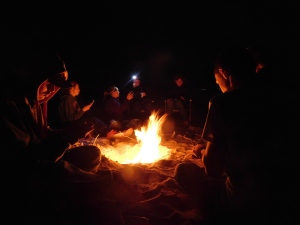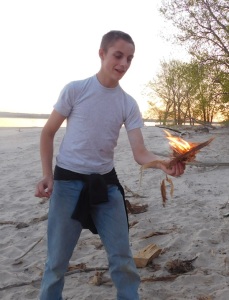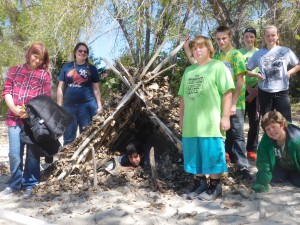Recently the 6th graders from Revere schools got their hands dirty during a Hatchet survival lesson. The results were impressive.

Stories around the campfire were just one high point of the lesson.
The best part about teaching is when you know you hit a home run. Whether it is a lesson that gets kids fired up, saying the right thing to a kid looking for guidance, or the well placed joke that lightens the mood, sometimes you can just feel good about what you do. In the past few days I was lucky enough to get that home run feeling with a lively group of 6th graders from Revere public schools.
Principal Brandon Marques got ahold of me several months ago and asked if I was interested in teaching an outdoor education lesson to the 6th grade at his school. Without any hesitation I told him I was certainly interested and we started planning the details. Over the course of a few weeks I came to understand that Mrs. Green’s class was reading the book Hatchet, and they were looking to take the lessons to the real world. Oddly enough, I had never read the book before. After reading it I realized how many great outdoor lessons were in the book. In the week’s preceding the class I worked with folks at Revere to get everything lined up for what was to be a great lesson.
It was Thursday night when we all finally got together. The sun hung high over Lake McConaughy and the weather was fantastic. After a brief hello to the class we got right to work. The first lesson would be in fire making, one of humanity’s greatest accomplishments. We first learned a little about fire, the three ingredients fire needs, and how important fire was to Brian (the main character from Hatchet). Since Brian had basically used a flint and steel set to get his fire going, the students would do the same. Before getting started we learned and reviewed the elements of a flint and steel fire including your tinder, flint, steel, and char. The kids quickly picked it up and soon we were ready to get started.
One important lesson we reviewed before actually beginning to make fire, is the importance of getting your fire ingredients organized. Kids used cottonwood cambium and dry grasses for tinder. Sky reminded us all that Brian had used a $20 bill unsuccessfully to get his fire going. Soon we remembered he used birch bark in the story to successfully create fire. Needless to say, by the time the kids were done they had created 7 excellent tinder bundles for their fire starting projects.

All the students got the satisfaction of actually holding fire in their hands.
We let the kids decide between two different fire starting methods; flint and steel and a ferro rod. Both are similar to what Brian used. Within the first few minutes things were going great and Jenna was able to get a fire going on her very first try. Soon Allie and Nikko followed suit and we had several students actually holding fire. In addition to the fire, they also held a better sense of Brian’s accomplishments in their hands. Talk about bringing the story to life in Living Literature lesson. Eventually all students would get their tinder bundle burning. Some went on to create several different fires.
Around the campfire that night students ate a hearty meal and told countless stories while lit up by the primitive glow of the firelight. I learned about Mrs. Green’s 6th grade class, how Andy likes to put firecrackers in his mom’s microwave, and about all the awesome projects the kids have gotten to do. With our Neanderthal TV (fire) blazing, we got to feel the warmth and contentment only a fire can provide. Needless to say, with a warm fire burning and stars shining overhead, it was a great night.
The next morning I showed up to see the class failing at their attempt to get their breakfast campfire going. They were testing out a modern form of fire starting and hadn’t planned for the fire very well. After a few quick questions the class realized where they had gone awry and rapidly rebuilt their fire base. Within a few minutes they had their fire going. The best part was they had done the problem solving on their own, and fixed their own mistake.
After a bite to eat the class and I ventured down the beach to find a suitable location for our morning shelter building project. During the walk the class learned that under the right conditions shelter should be the first priority in a situation where you are caught in the woods. Within a few minutes we found a great location with everything we needed within a close distance. After reviewing the basics of a shelter we got started building our debris hut. During the building kids learned about insulation, natural cordage, and how to break sticks. Big….actually, huge sticks. Josh took the lead as the master stick breaker and provided us with plenty of material for our shelter. Within the hour we had a good thing going and our shelter was coming along nicely.
We took a break to review the elements of a shelter and grab a bite to eat. The cinnamon rolls in orange peels were delicious and supplied us with some extra energy for the job. Throughout the Hatchet survival lesson we constantly talked about food, calories, and how Brian had to balance his time and energy while stranded. At this point Mrs. Green and I also were able to give the kids a crash demonstration in how erosion works. One fun thing about teaching this way is capitalizing on teaching points as they come up. It seems to help both teaching and learning.
After our second breakfast we headed back to complete our shelter. The debris hut required us to pile dead leaves thickly over the entire shelter frame we had made. Everybody chipped in and within no time we were making some progress. Hunter was someone who stood out during the process as a guy who you could depend on to get the job done. He was a big help throughout. Once we got the shelter built we only had a few minutes to enjoy our creation and then it was time to tear it down. With only a few hours left in our time together, it was time to begin our last lesson.

Completed debris hut with the Revere 6th grade.
As Brian began to get settled in to his routine in the bush, he had to get food. Although he tried many methods, he quickly realized that fish were abundant in the area. In order to catch fish easily, and store them live, he decided to built a fish trap. During our Living Literature lesson on Hatchet, we would do the same.
It is worth thanking the Nebraska Game and Parks game warden Terry Brenzal at this point. You see, building fish traps in Nebraska is illegal. A few days before our lesson I called Terry and asked him if we could build one for the project. I explained what we were doing, and that we wouldn’t actually be trying to catch fish. After getting a feel for our project Terry gave me the go-ahead to build them in the name of education. It is important to note lots of good people were involved with bringing this lesson together, and Mr. Brenzal is one who deserves a thank you.
For the fish trap project I diagramed how the trap should be laid out, and gave a few tips on where it should be. Fish traps are pretty simple devices and the basics take only a few minutes to teach. As we got ready to build, I got a chance to see the competitive nature of the class take over. Rather than build one fish trap as a class, they wanted to build two separate one. Boys against girls of course. With the teams set, each party began earnest construction of their traps. Bouncing back between teams, I could see how each team was approaching the project differently. The boys wanted a build a big trap and wanted to go into deep water. The girls opted for a smaller trap, and used a dead carp they found as “bait”. It was fun to see them get into the project and see their creativity take over. After the traps were complete we took a few pictures then tore them down.

Girl’s fish trap.

Boy’s fish trap.
All in all, the Hatchet survival lesson was a hit. Students got a chance to actually live out some of the skills Brian used in the story. Throughout the lesson they were challenged to use their minds to solve problems, scan the world for things they could use, and work together as a team to accomplish a goal. It is safe to say that after our lesson, their understanding of the book went to a whole new level.
I’d like to give a huge thank you to Mrs. Green and Mr. Marquez for allowing me to be involved with this lesson. It was a great experience to teach an engaging outdoor lesson to the kids. Hopefully this lesson can highlight what the folks at Revere, and public schools all over, are doing to help kids learn. Thanks!
XXXXX
Thanks for taking the time to read this article about the Hatchet Living Literature lesson. If you like the content, I’d encourage you to follow the blog by clicking the Follow button near the bottom of this page. You may also enjoy this article about the atlatl course I taught at Revere earlier this year.
Follow the author through his Facebook page.
Sounds like it was a great time.
What a blast. Those are some lucky students!
LikeLike